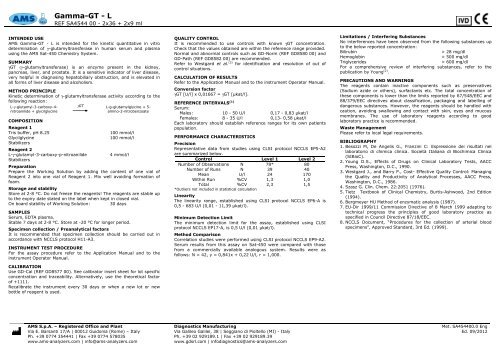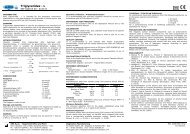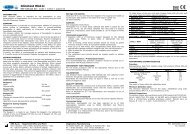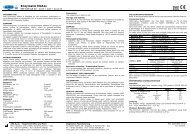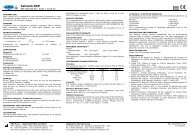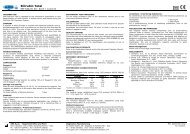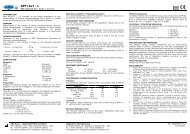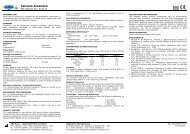Gamma-GT - L - Gdsrl.com
Gamma-GT - L - Gdsrl.com
Gamma-GT - L - Gdsrl.com
Create successful ePaper yourself
Turn your PDF publications into a flip-book with our unique Google optimized e-Paper software.
<strong>Gamma</strong>-<strong>GT</strong> - L<br />
REF SA4544 00 - 2x36 + 2x9 ml<br />
INTENDED USE<br />
AMS <strong>Gamma</strong>-<strong>GT</strong> - L is intended for the kinetic quantitative in vitro<br />
determination of γ-glutamyltransferase in human serum and plasma<br />
using the AMS Sat-450 Chemistry System.<br />
SUMMARY<br />
γ<strong>GT</strong> (γ-glutamyltransferase) is an enzyme present in the kidney,<br />
pancreas, liver, and prostate. It is a sensitive indicator of liver disease,<br />
very helpful in diagnosing hepatobiliary obstruction, and is elevated in<br />
all forms of liver disease and alcoholism.<br />
METHOD PRINCIPLE<br />
Kinetic determination of γ-glutamyltransferase activity according to the<br />
following reaction:<br />
L-γ-glutamyl-3-carboxy-4nitroanilide<br />
+ glycilglycine<br />
COMPOSITION<br />
γ<strong>GT</strong><br />
L-g-glutamylglycine + 5amino-2-nitrobenzoate<br />
Reagent 1<br />
Tris buffer, pH 8.25 100 mmol/l<br />
Glycilglycine 100 mmol/l<br />
Stabilizers<br />
Reagent 2<br />
L-γ-glutamyl-3-carboxy-p-nitroanilide 4 mmol/l<br />
Stabilizers<br />
Preparation<br />
Prepare the Working Solution by adding the content of one vial of<br />
Reagent 2 into one vial of Reagent 1. Mix well avoiding formation of<br />
foam.<br />
Storage and stability<br />
Store at 2-8 °C. Do not freeze the reagents! The reagents are stable up<br />
to the expiry date stated on the label when kept in closed vial.<br />
On board stability of Working Solution: 30 days<br />
SAMPLES<br />
Serum, EDTA plasma.<br />
Stable 7 days at 2-8 °C. Store at -20 °C for longer period.<br />
Specimen collection / Preanalytical factors<br />
It is re<strong>com</strong>mended that specimen collection should be carried out in<br />
accordance with NCCLS protocol H11-A3.<br />
INSTRUMENT TEST PROCEDURE<br />
For the assay procedure refer to the Application Manual and to the<br />
instrument Operator Manual.<br />
CALIBRATION<br />
Use GD-Cal (REF GD8577 00). See calibrator insert sheet for lot specific<br />
concentration and traceability. Alternatively, use the theoretical factor<br />
of +1111.<br />
Recalibrate the instrument every 30 days or when a new lot or new<br />
bottle of reagent is used.<br />
QUALITY CONTROL<br />
It is re<strong>com</strong>mended to use controls with known γ<strong>GT</strong> concentration.<br />
Check that the values obtained are within the reference range provided.<br />
Normal and abnormal controls such as GD-Norm (REF GD8580 00) and<br />
GD-Path (REF GD8582 00) are re<strong>com</strong>mended.<br />
Refer to Westgard et al. (3) for identification and resolution of out of<br />
control situations.<br />
CALCULATION OF RESULTS<br />
Refer to the Application Manual and to the instrument Operator Manual.<br />
Conversion factor<br />
γ<strong>GT</strong> [U/l] x 0,01667 = γ<strong>GT</strong> [µkat/l].<br />
REFERENCE INTERVALS (1)<br />
Serum:<br />
Males: 10 - 50 U/l 0,17 - 0,83 µkat/l<br />
Females: 8 - 35 U/l 0,13- 0,58 µkat/l<br />
Each laboratory should establish reference ranges for its own patients<br />
population.<br />
PERFORMANCE CHARACTERISTICS<br />
Precision<br />
Representative data from studies using CLSI protocol NCCLS EP5-A2<br />
are summarized below.<br />
Control Level 1 Level 2<br />
Number of Observations N 78* 80<br />
Number of Runs N 39 40<br />
Mean U/l 24 170<br />
Within Run %CV 1,3 1,0<br />
Total %CV 2,3 1,5<br />
*Outliers not included in statistical calculation<br />
Linearity<br />
The linearity range, established using CLSI protocol NCCLS EP6-A is<br />
0,5 - 683 U/l (0,01 - 11,39 µkat/l).<br />
Minimum Detection Limit<br />
The minimum detection limit for the assay, established using CLSI<br />
protocol NCCLS EP17-A, is 0,5 U/l (0,01 µkat/l).<br />
Method Comparison<br />
Correlation studies were performed using CLSI protocol NCCLS EP9-A2.<br />
Serum results from this assay on Sat-450 were <strong>com</strong>pared with those<br />
from a <strong>com</strong>mercially available analogous system. Results were as<br />
follows: N = 42, y = 0,841x + 0,22 U/l, r = 1,000.<br />
AMS S.p.A. – Registered Office and Plant Diagnostics Manufacturing<br />
Via E. Barsanti 17/A | 00012 Guidonia (Rome) – Italy Via Galileo Galilei, 38 | Seggiano di Pioltello (MI) - Italy<br />
Ph. +39 0774 354441 | Fax +39 0774 578035 Ph. +39 02 929189.1 | Fax +39 02 929189.39<br />
www.ams-analyzers.<strong>com</strong> | info@ams-analyzers.<strong>com</strong> www.gdsrl.<strong>com</strong> | infodiagnostics@ams-analyzers.<strong>com</strong><br />
Limitations / Interfering Substances<br />
No interferences have been observed from the following substances up<br />
to the below reported concentration:<br />
Bilirubin > 28 mg/dl<br />
Hemoglobin > 500 mg/dl<br />
Triglycerides > 600 mg/dl<br />
For a <strong>com</strong>prehensive review of interfering substances, refer to the<br />
publication by Young (2) .<br />
PRECAUTIONS AND WARNINGS<br />
The reagents contain inactive <strong>com</strong>ponents such as preservatives<br />
(Sodium azide or others), surfactants etc. The total concentration of<br />
these <strong>com</strong>ponents is lower than the limits reported by 67/548/EEC and<br />
88/379/EEC directives about classification, packaging and labelling of<br />
dangerous substances. However, the reagents should be handled with<br />
caution, avoiding swallowing and contact with skin, eyes and mucous<br />
membranes. The use of laboratory reagents according to good<br />
laboratory practice is re<strong>com</strong>mended.<br />
Waste Management<br />
Please refer to local legal requirements.<br />
BIBLIOGRAPHY<br />
1. Besozzi M, De Angelis G., Franzini C: Espressione dei risultati nel<br />
laboratorio di chimica clinica. Società Italiana di Biochimica Clinica<br />
(SIBioC).<br />
2. Young D.S., Effects of Drugs on Clinical Laboratory Tests, AACC<br />
Press, Washington, D.C., 1990.<br />
3. Westgard J., and Barry P., Cost- Effective Quality Control: Managing<br />
the Quality and Productivity of Analytical Processes, AACC Press,<br />
Washington, D.C., 1986.<br />
4. Szasz G. Clin. Chem. 22:2051 (1976).<br />
5. Tietz Textbook of Clinical Chemistry, Burtis-Ashwood, 2nd Edition<br />
(1994).<br />
6. Bergmeyer HU Method of enzymatic analysis (1987).<br />
7. EU-Dir 1999/11 Commission Directive of 8 March 1999 adapting to<br />
technical progress the principles of good laboratory practice as<br />
specified in Council Directive 87/18/EEC.<br />
8. NCCLS Document, “Procedures for the collection of arterial blood<br />
specimens”, Approved Standard, 3rd Ed. (1999).<br />
Met. SA454400.0 Eng<br />
Ed. 09/2012
<strong>Gamma</strong>-<strong>GT</strong> - L<br />
REF SA4544 00 - 2x36 + 2x9 ml<br />
USO<br />
Il kit AMS <strong>Gamma</strong>-<strong>GT</strong> - L viene impiegato per la determinazione<br />
cinetica quantitativa in vitro della γ-glutamiltransferasi nel siero e urina<br />
umano con sistema AMS Sat-450.<br />
SOMMARIO<br />
La γ<strong>GT</strong> (γ-glutamiltransferasi) è un enzima presente nel rene, nel<br />
pancreas, nel fegato e nella prostata. E’ un indicatore sensibile per le<br />
patologie epatiche, molto utile nella diagnosi di ostruzione epatobiliare<br />
e la sua attività è elevata in tutte le forme di malattie del fegato ed<br />
alcolismo.<br />
PRINCIPIO<br />
Determinazione cinetica dell’attività γ-glutamiltransferasica secondo la<br />
seguente reazione:<br />
L-γ-glutamil-3-carbossi-4nitroanilide<br />
+ glicilglicina<br />
COMPOSIZIONE<br />
γ<strong>GT</strong><br />
L-g-glutamilglicina + 5amino-2-nitrobenzoato<br />
Reagente 1<br />
Tampone Tris, pH 8.25 100 mmol/l<br />
Glicilglicina 100 mmol/l<br />
Stabilizzanti<br />
Reagente 2<br />
L-γ-glutamil-3-carbossi-p-nitroanilide 4 mmol/l<br />
Stabilizzanti<br />
Preparazione<br />
Preparare la Soluzione di Lavoro versando il contenuto di un flacone di<br />
Reagente 2 in un flacone di Reagente 1. Miscelare bene evitando la<br />
formazione di schiuma.<br />
Conservazione e Stabilità<br />
Conservare a 2-8 °C. Non congelare i reattivi! I reattivi sono stabili fino<br />
alla data di scadenza riportata in etichetta, se conservati in flacone<br />
chiuso.<br />
Stabilità a bordo dello strumento della Soluzione di Lavoro: 30 giorni<br />
CAMPIONI<br />
Siero, plasma EDTA.<br />
Stabile 7 giorni a 2-8 °C. Stoccare a -20 °C per periodi più lunghi.<br />
Raccolta dei Campioni / Fattori Preanalitici<br />
Si rac<strong>com</strong>anda di effettuare la raccolta dei campioni in conformità al<br />
Protocollo NCCLS H11-A3.<br />
PROCEDURA DI ANALISI<br />
Per la procedura di analisi fare riferimento all’Application Manual e al<br />
Manuale dell’Operatore dello strumento.<br />
CALIBRAZIONE<br />
Utilizzare GD-Cal (REF GD8577 00). Riferirsi all’inserto del calibratore<br />
per la concentrazione specifica del lotto e la tracciabilità.<br />
Alternativamente utilizzare il fattore teorico di +1111.<br />
Ricalibrare lo strumento ogni 30 giorni o quando viene utilizzato un<br />
nuovo lotto o una nuova bottiglia di reagente.<br />
CONTROLLO DI QUALITA’<br />
Si rac<strong>com</strong>anda l’uso di controlli a titolo noto di γ<strong>GT</strong>. Verificare che il<br />
valore ottenuto sia all’interno degli intervalli di accettabilità forniti. Si<br />
consiglia l’uso di controlli Normale e Patologico <strong>com</strong>e GD-Norm (REF<br />
GD8580 00) e GD-Path (REF GD8582 00).<br />
Far riferimento a Westgard et al. (3) per l’identificazione e la risoluzione<br />
di problematiche legate ai controlli fuori dai limiti.<br />
CALCOLO DEI RISULTATI<br />
Riferirsi all’Application Manual e al Manuale dell’Operatore dello<br />
strumento.<br />
Fattori di Conversione<br />
γ<strong>GT</strong> [U/l] x 0,01667 = γ<strong>GT</strong> [µkat/l].<br />
INTERVALLO DI RIFERIMENTO (1)<br />
Siero:<br />
Uomini: 10 - 50 U/l 0,17 - 0,83 µkat/l<br />
Donne: 8 - 35 U/l 0,13- 0,58 µkat/l<br />
Si rac<strong>com</strong>anda ad ogni laboratorio di stabilire i propri valori normali in<br />
funzione della popolazione su cui opera.<br />
PRESTAZIONI ANALITICHE<br />
Precisione<br />
Dati rappresentativi dello studio secondo il protocollo CLSI NCCLS<br />
EP5-A2 sono sotto riportati.<br />
Controllo Livello 1 Livello 2<br />
Numero di Osservazioni N 78* 80<br />
Numero di Prove N 39 40<br />
Media U/l 24 170<br />
Nella Corsa %CV 1,3 1,0<br />
Totale %CV 2,3 1,5<br />
*Valori fuori limite non inclusi nei calcoli statistici<br />
Linearità<br />
L’intervallo di linearità, stabilito tramite il protocollo CLSI NCCLS EP6-A<br />
è risultato pari a 0,5 - 683 U/l (0,01 - 11,39 µkat/l).<br />
Limite Minimo di Rivelabilità<br />
Il limite minimo di rilevabilità, stabilito tramite il protocollo CLSI NCCLS<br />
EP17-A, è 0,5 U/l (0,01 µkat/l).<br />
Comparazione fra Metodi<br />
Studi di correlazione sono stati effettuati secondo il protocollo CLSI<br />
NCCLS EP9-A2. I risultati dei sieri di questo dosaggio su Sat-450 sono<br />
stati confrontati con un sistema analogo presente in <strong>com</strong>mercio. I<br />
risultati sono stati i seguenti: N = 42, y = 0,841x + 0,22 U/l, r =<br />
1,000.<br />
AMS S.p.A. – Sede Legale e Stabilimento Produzione Diagnostici<br />
Via E. Barsanti 17/A | 00012 Guidonia (Roma) – Italia Via Galileo Galilei, 38 | Seggiano di Pioltello (MI) - Italia<br />
Tel. +39 0774 354441 | Fax +39 0774 578035 Tel. +39 02 929189.1 | Fax +39 02 929189.39<br />
www.ams-analyzers.<strong>com</strong> | info@ams-analyzers.<strong>com</strong> www.gdsrl.<strong>com</strong> | infodiagnostics@ams-analyzers.<strong>com</strong><br />
Limitazioni / Sostanze Interferenti<br />
Nessuna interferenza è stata osservata dalle seguenti sostanze fino alla<br />
concentrazione sotto indicata:<br />
Bilirubina > 28 mg/dl<br />
Emoglobina > 500 mg/dl<br />
Trigliceridi > 600 mg/dl<br />
Per una panoramica <strong>com</strong>pleta sulle sostanze interferenti si rimanda alla<br />
pubblicazione di Young (2) .<br />
PRECAUZIONI E AVVERTENZE<br />
I reagenti contengono <strong>com</strong>ponenti inattivi, quali i conservanti (Sodio<br />
azide o altri), tensioattivi ecc. La concentrazione totale di questi<br />
<strong>com</strong>ponenti è inferiore ai limiti riportati dalle direttive CEE 67/548/EEC<br />
e 88/379/EEC sulla classificazione, l’imballaggio ed etichettatura delle<br />
sostanze pericolose. Tuttavia i reagenti devono essere trattati con<br />
cautela, evitandone l’ingestione, il contatto con la pelle, gli occhi e le<br />
membrane mucose.<br />
Nell’utilizzo dei reagenti di laboratorio si rac<strong>com</strong>anda di seguire le<br />
norme di buona pratica di laboratorio.<br />
Gestione dei Rifiuti<br />
Attenersi alle norme locali per quanto riguarda lo smaltimento dei<br />
reagenti.<br />
BIBLIOGRAFIA<br />
1. Besozzi M, De Angelis G., Franzini C: Espressione dei risultati nel<br />
laboratorio di chimica clinica. Società Italiana di Biochimica Clinica<br />
(SIBioC).<br />
2. Young D.S., Effects of Drugs on Clinical Laboratory Tests, AACC<br />
Press, Washington, D.C., 1990.<br />
3. Westgard J., and Barry P., Cost- Effective Quality Control: Managing<br />
the Quality and Productivity of Analytical Processes, AACC Press,<br />
Washington, D.C., 1986.<br />
4. Szasz G. Clin. Chem. 22:2051 (1976).<br />
5. Tietz Textbook of Clinical Chemistry, Burtis-Ashwood, 2nd Edition<br />
(1994).<br />
6. Bergmeyer HU Method of enzymatic analysis (1987).<br />
7. EU-Dir 1999/11 Commission Directive of 8 March 1999 adapting to<br />
technical progress the principles of good laboratory practice as<br />
specified in Council Directive 87/18/EEC.<br />
8. NCCLS Document, “Procedures for the collection of arterial blood<br />
specimens”, Approved Standard, 3rd Ed. (1999).<br />
Met. SA454400.0 Ita<br />
Ed. 09/2012


